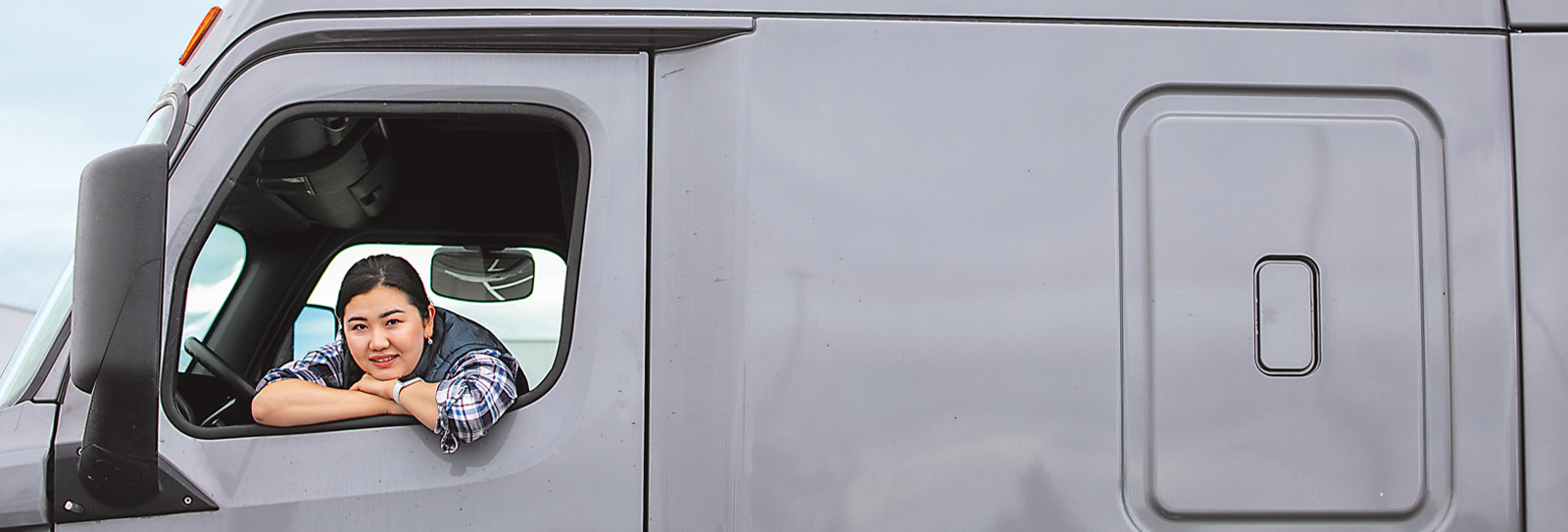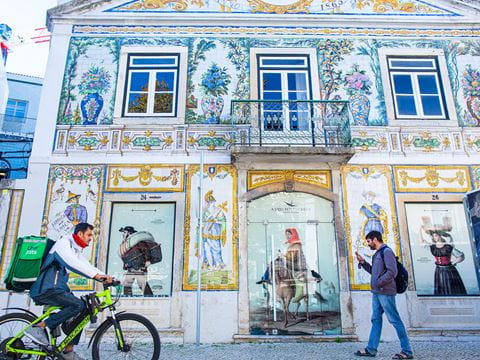
Central Asian Women Truck Drivers: Analyzing Gender Stereotypes
Women Studies
Anthropology
Central Asia
Americas
Julie Weiss
Meet women who are breaking stereotypes and making a good living doing so.
The following activities and abridged text build off “Central Asian Women Hit the US Road,” written by J. Trevor Williams and photographed by Bear Gutierrez.
WARM UP
Before reading the article or doing the activities, complete this warm-up activity to hypothesize the theme and main idea of the article.
IF YOU ONLY HAVE 15 MINUTES ...
In this activity, locate the countries and regions featured in the article and explain their importance.
IF YOU ONLY HAVE 30 MINUTES ...
In this activity, discuss how people from Central Asia, particularly women, are part of a movement creating more economic opportunity and greater equality for people of increasingly diverse backgrounds.
VISUAL ANALYSIS
In this activity, explore different ways of telling a story—with words or with images; and compare visual images with stereotypes to see how images can counter expectations.
Directions: As you read, you will notice certain words are highlighted. See if you can figure out what these words mean based on the context. Then click the word to see if you’re right.
Central Asian Truckers Hit the US Road

“I look at it [trucking] as a spiritual way of being a nomad—seeing places, seeing people, expanding your boundaries as much as you can.”
—Aidana Tokenova, Denver, Colorado
Looking out at the glistening waters of the Gulf of Mexico, Arailym Mergenova remembers as a child peering westward from Aktau, Kazakhstan, to the Caspian Sea. “When I opened my door, I saw the sea every time,” she says.
But her dreams took her far afield. As a girl in the mid-1990s, she “dreamed about seeing every state in the USA.”
After college, she landed in Panama City Beach, Florida, thanks to a US student-exchange visa. In 2015, after two summers working in Florida, Mergenova, by then also married, returned to Panama City Beach for good with her husband.
Mergenova says her next career move was not intentional. But “it’s true,” she concedes, that “we were nomadic people hundreds of years ago… [Still,] “everybody chooses their own reason to be a truck driver.”
At age 23, Mergenova passed the State of Florida’s Commercial Driver License exam.
Women truckers are rare in the US and even more so when counting those who are also immigrants. Mergenova is however part of a growing cadre from traditionally Turkic nomadic cultures of Central Asia, where, for thousands of years, people have found identity in their searches for pasture.

“It’s true that we were nomadic people hundreds of years ago, but everybody chooses their own reason to be a truck driver.”
—Arailym Mergenova, Panama City Beach, Florida

“That’d be really good for me, and I know how to run this business.”
—Aisha Meirmanova, in Denver, Colorado, explaining her dream of using earnings from driving 18-wheelers to open a food truck serving coffee and breakfast.
Some acknowledge they carry this heritage across continents and behind the wheel. Aidana Tokenova is a 29-year-old trucker-in-training from Kazakhstan. While the main allure of trucking is the paycheck, she says, the prospect of hitting the road with her husband hits home.
“I look at it in the spiritual way of being a nomad. Seeing places, seeing people, expanding your boundaries as much as you can,” she says. “It’s all I’ve got left—my last name and my heritage, since I’m so far from home.”
For others like Mergenova, such desire to roam feels only tenuously linked to this history. It feels more pragmatic and entrepreneurial. It feels downright American.
“There is a lot of movement that is reminiscent of nomadism” in modern life, says Jonathan Washington. He is an expert on Kyrgyz language and culture at Swarthmore College in Pennsylvania. He explains that it remains common in the Turkic-speaking cultures of Central Asia for even the most urbane professionals to feel deeply linked by family and tradition to herding life.
![“My husband, he helps me. He’s my passenger and he’s my guide. For seven months [because of him] I haven’t received driving tickets.”
—Amina Alykulova, Cincinnati, Ohio—where both she and her husband, Adilet Ramanov, also work as professional wrestlers.](https://www.aramcoworld.com/-/media/aramco-world/lessons/2022/central-asian-truckers-banner-images/image-4.jpg)
“My husband, he helps me. He’s my passenger and he’s my guide. For seven months [because of him] I haven’t received driving tickets.”
—Amina Alykulova, Cincinnati, Ohio—where both she and her husband, Adilet Ramanov, also work as professional wrestlers.
Driving trucks, he says, can bridge the gap between modern life and traditional nomadic life. But for women, in Central Asia as in the US, the industry is almost exclusively a men’s club.
When she learned about truck driving from her friend Micka, who was pulling down $2,500 some weeks, Mergenova grew enchanted. But she also knew she’d face resistance.
“Men think that if you’re a woman, you should sit at home,” she says. “’Where is your husband? Why can’t he do these things? You should sit home and birth babies and cook.’ Everybody talked to me like that.”
But the sight of her friend working in the cab of an 18-wheeler fed her confidence. Mergenova’s husband also encouraged her. In fact, he got his license too.
Their timing couldn’t have been better: Trucking in the US is at an inflection point. More drivers are needed, because of the pandemic and retirements. Still, more than three-quarters of US truck drivers are white; only eight percent are women.
That’s changing as Punjabis, Russians, Eastern Europeans, Mexicans and Central Americans get behind the wheel. In 2020, foreign-born drivers made up 16.6 percent of the total, according to the Institute for Immigration Research at George Mason University. Among them, women accounted for just 4.9 percent.
That balance could change as the industry starts to see the value of women. So says Ellen Voie, president and CEO of the Women in Trucking Association, a Wisconsin nonprofit that advocates for gender diversity in the trucking industry.
Female commercial drivers, she points out, are 20 percent less likely than their male counterparts to be involved in an accident. Women drivers also accept training easily, lead with empathy and excel at many of the customer-facing aspects of the profession, she adds. Perception remains the problem.

“We’re all immigrants, so we’re here to do—to make money to provide bread for our families.”
—Ramiz Kerimov, Chicago, Illinois
“People think you need to be big and burly. They think you need to be mechanically minded. They think you need to be away from home for days at a time. None of those are true anymore,” Voie says.
Trucks are so high tech now that drivers rarely touch the engines. And women can make an entire career out of short- and medium-haul jobs like transporting shipping containers and running waste-management routes. That means that even women with children may start seeing this as a viable career, Voie says.
For Aisha Meirmanova, finding a local gig will be essential. 26 years old, and mother of a year-old daughter, she lives near Denver, where the dry air and mountains remind her of home.
Now in training, she hopes trucking will help her and her husband save for the future while not missing out on their daughter’s present.
Mergenova finds it hard to pinpoint why resistance to her work emerged back home. Turkic steppe culture had a reputation for flexibility in matters of gender-based labor. True, women generally covered the domestic realm and men generally handled herding duties. But women always contributed to the family’s livelihood. And anytime a “male” task didn’t get done—like slaughtering sheep—women stepped up to do it, Washington says.
Add to that the experience of nearly a century under Soviet rule, which encouraged and expected women to work, says Ajar Chekirova. Chekirova is a Kyrgyzstan-born assistant professor of politics at Lake Forest College, near Chicago, who has studied immigrant livelihoods.
Especially in Chicago, long a trucking hub thanks to its location near the center of the US, Chekirova says the industry has become popular with Central Asians.

“’You should sit home and birth babies and cook.’ Everybody talked to me like that. It’s so heavy when women start in the trucking business. ... I’m just keeping positive.”
—Arailym Mergenova
“In any community gathering you go to, you will find people who work in the industry. It’s definitely very visible.” Chekirova says.
And in a new culture, women from the region are finding the doors unlocked.
***
“I don’t judge people for whatever their gender is,” says Ramiz Kerimov, 34, who runs N and N Transportation, a dispatching firm in Denver. “For me, the most important is communication.”
Only three of N and N Transportation’s 42 trucks are driven by women from Central Asia.
Kerimov, an immigrant from Turkmenistan, drove trucks for the good pay. But he didn’t like the work. “I felt like it’s a dog’s life. You’re always in a box,” he says.
Kerimov turned to dispatching. He finds loads for owner-operators and manages back-office tasks like registration, accounting, safety compliance and cargo logs. Doing this work keeps him in the industry without being away all the time.
“Trucking does sometimes divorce people,” he says. “I want my son to see there is a dad next to him.”

“At first it was lonely for me, but you get used to it as time goes on, and you start to socialize with other female truckers.”
—Albina Bekicheva, Chicago
Mergenova, however, embraced the lifestyle, while adapting it to meet her needs. While waiting on a load, she says, she’d often forgo a truck stop and find instead a nearby Walmart. There she’d hit the nail salon and touch up her makeup. “People were always asking, ‘Why are you doing your eyelashes? Nobody’s seeing you in the truck.’ I’d say, ‘Are you kidding? I’m doing it for myself, not for somebody else. I need to feel like my real self.’”
Along the way, she also fulfilled her dream of traveling to all 48 contiguous US states. Two years in, she and her husband bought their own trucks. Blending her loves of travel and photography, she posted bright photos of her experiences on Instagram and amassed more than 75,000 followers. In February 2020, Kazakh website BaigeNews ran an article about her titled “Trucker Lady.” A few criticisms followed, but to her the important comments came from women who said she’d become an inspiration.
Women truckers use social media to stay in touch, and to encourage each other. Albina Bekicheva, 34, used the support of the online community to start driver training and, license in hand, settled into driving.
“At first it was lonely for me, but you get used to it as time goes on. You also start to socialize with other female truckers. We call each other on the phone a lot,” Bekicheva says. Apps like Zenly and Live360 facilitate in-person meetups in cities across the country.
For Mergenova’s part, driving has become easier, now that she owns her white 2015 Freightliner Cascadia and can pick and choose routes that—ideally—lead from one clean, well-lit warehouse to another. With so many companies clamoring for drivers, job security feels high.
But other roads, too, beckon. At home in Florida, as she prepares to hang up from a phone interview, ambient cooing from her infant daughter fills the room.
Now 29, she says she’s ready to get back to driving, confident that she’ll find a balance between work and family.
“I try to only remember the good things throughout the day, like a smile, when someone opens a door for me, or when someone gave me a compliment,” she says. “When you pay attention to the happy things, happy things have a way of pulling you in.”
Other lessons

Tracing the History and Geography of Portuguese Tile Making
Geography
Architecture
Europe
Analyze how culture and technology have changed the ways tiles have been made in Portugal for over 500 years.
Teaching Empathy: Five Classroom Activities From AramcoWorld
For the Teacher's Desk
Help students build empathy and community for the academic year with AramcoWorld’s stories and Learning Center lessons.
Interpret Tradition in Transition: Remix⟷Culture’s Role in Reviving and Reimagining Folk Music
Media Studies
Art
North Africa
Americas
Investigate how traditional melodies gain new life through Belyamani’s blend of cultural preservation and cutting-edge remix artistry.